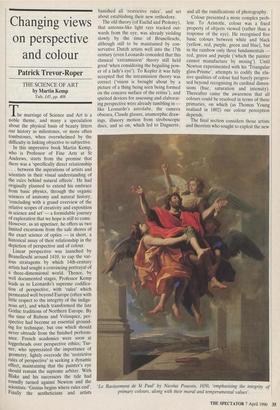Changing views on perspective and colour
Patrick Trevor-Roper
THE SCIENCE OF ART by Martin Kemp Yale, f45, pp. 408 The marriage of Science and Art is a noble theme, and many a speculation about the physical basis of beauty litters our history as milestones, or more often tombstones, when overwhelmed by the difficulty in linking objective to subjective.
In this impressive book Martin Kemp, who is Professor of Fine Arts at St Andrews, starts from the premise that there was a 'specifically direct relationship • . . between the aspirations of artists and scientists in their visual understanding of the rules behind natural effects'. He had originally planned to extend his embrace from basic physics, through the organic sciences of anatomy and natural history, `concluding with a grand overview of the relative scopes of creativity and exposition in science and art' — a formidable journey of exploration that we hope is still to come. However, as an appetiser, he offers us two limited excursions from the safe shores of the exact science of optics — in short, a historical assay of their relationship in the depiction of perspective and of colour.
Linear perspective was launched by Brunelleschi around 1410, to cap the var- ious stratagems by which 14th-century artists had sought a convincing portrayal of a three-dimensional world. Thence, by well documented stages, Professor Kemp leads us to Leonardo's supreme codifica- tion of perspective, with 'rules' which permeated well beyond Europe (often with little respect to the integrity of the indige- nous art), and which transformed the late Gothic traditions of Northern Europe. By the time of Rubens and Velasquez, per- spective had become an essential ground- ing for technique, but one which should never obtrude from the finished perform- ance. French academics were soon at loggerheads over perspective ethics; Tur- ner, who appreciated the importance of geometry, lightly overrode the 'restrictive rules of perspective' in seeking a dynamic effect, maintaining that the painter's eye should remain the supreme arbiter. With Blake and his successors the tide had roundly turned against Newton and the scientists: 'Genius begins where rules end'. Finally the aestheticians and artists banished all 'restrictive rules', and set about establishing their new orthodoxy.
The old theory (of Euclid and Ptolemy), that antenna-like light rays tracked out- wards from the eye, was already yielding slowly by the time of Brunelleschi, although still to be maintained by con- servative Dutch artists well into the 17th century (even Leonardo conceded that this classical `extramission' theory still held good 'when considering the beguiling pow- er of a lady's eye'). To Kepler it was fully accepted that the intramission theory was correct (`vision is brought about by a picture of a thing being seen being formed on the concave surface of the retina'), and spirited devices for assessing and elaborat- ing perspective were already tumbling in like Leonardo's astrolabe, the camera obscura, Claude glasses, anamorphic draw- ings, illusory motion from stroboscopic discs, and so on, which led to Daguerre, and all the ramifications of photography.
Colour presented a more complex prob- lem. To Aristotle, colour was a fixed property of objects viewed (rather than a response of the eye). He recognised five basic colours between white and black (yellow, red, purple, green and blue), but in the rainbow only three fundamentals red, green and purple ('which the painter cannot manufacture by mixing'). Until Newton experimented with his `Triangular glass-Prisme', attempts to codify the elu- sive qualities of colour had barely progres- sed beyond recognising its cardinal dimen- sions (hue, saturation and intensity). Thereafter came the awareness that all colours could be resolved in terms of these primaries, on which (as Thomas Young realised in 1802) our colour perception depends.
The final section considers those artists and theorists who sought to exploit the new `Le Ravissement de St Paul' by Nicolas Poussin, 1650, 'emphasising the integrity of primary colours, along with their moral and temperamental values'. scientific knowledge of colour to paintings, particularly recalling Rubens (`breaking colours on the canvas rather than torment- ing them on the palette') and Poussin, who emphasised the integrity of primary colours, along with their moral and temp- eramental values (relating these to an equiv- alent value in musical notation and even adding an astrological gloss). Finally, the three-colour theory was imaginatively deployed by 19th-century French artists, leading up to the success of Seurat, who brought some order into the chaos.
This handsome book is ponderous and comprehensive, supported by hundreds of illustrations, with neat optical analyses alongside, and it amply covers these limited aspects of perspective and colour. Professor Kemp will have a harder task when he comes to marshall the 'organic sciences' into his Grand Design. After anatomy and natural history he will be faced with the uncertain physiological in- fluences in artistry (directional gaze and lateralism, ocular imbalance, the varied shapes of eyeball, colour-shifts from hered- ity, age, disease, tradition, drugs, tempera- ment and so on), and beyond these lie the tempting pastures of neuro-psychiatry. How splendid if he can keep up the momentum, as successive volumes dispose of all these ill-charted and provocative issues, already beckoning in the wings.



























































 Previous page
Previous page